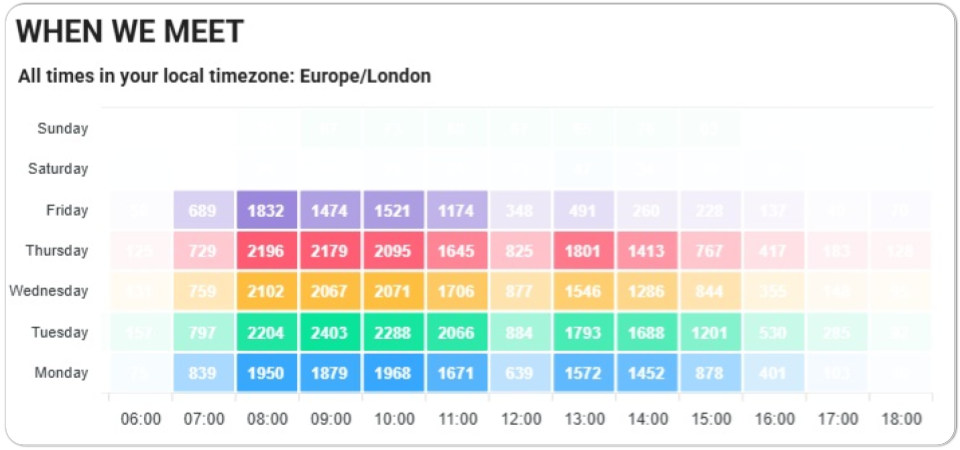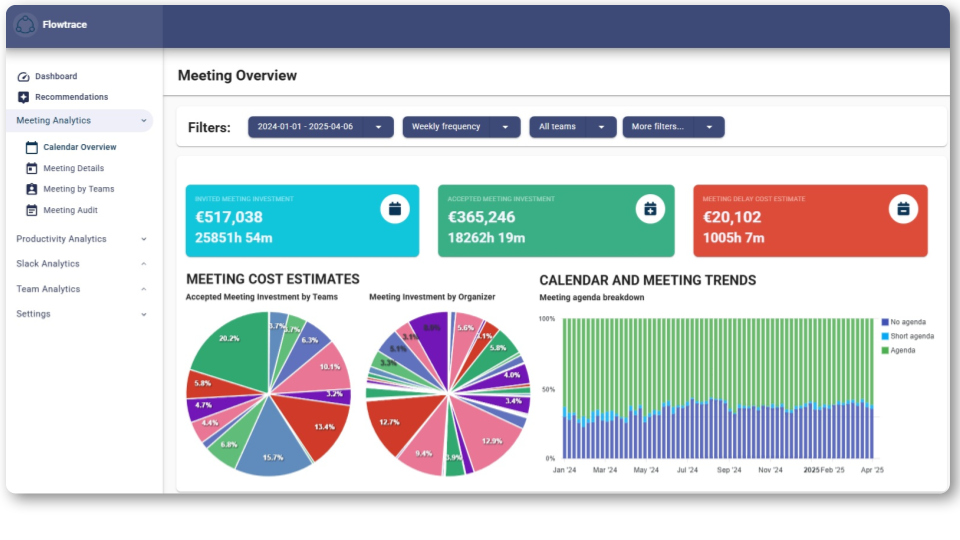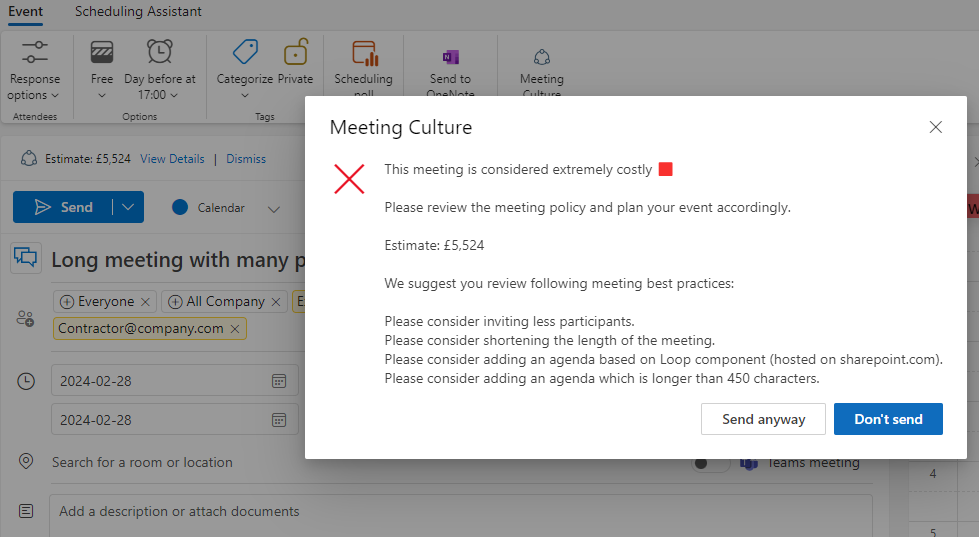Managing Remote Team Collaboration with Calendar Analytics
Boost remote team productivity and enhance remote work communication with calendar analytics. Discover how Flowtrace can help.
Learn how to change company meeting culture with clarity, structure, and consistent reinforcement using Flowtrace for data-driven improvements.
Meeting culture rarely gets discussed directly, but it influences almost everything: how your team spends time, how decisions are made, and how much focus people can protect during the week.
The challenge is that poor meeting culture doesn’t appear all at once. It builds slowly through default behaviors: every meeting gets booked for an hour, agendas are skipped, invites go out to 12 people instead of 4, and recurring meetings live on long after they’re useful.
Most companies don’t set out to have too many meetings or the wrong kinds. But without structure and visibility, those habits become normal.
To change that, you need two things: clarity on what’s broken, and the right systems to support change. This article will help you do both, first by understanding your current meeting culture, then by showing how to take control of it using Flowtrace.
This article covers the end to end meeting transformation steps:

Before you can fix meeting culture, you have to know what you're working with. Too often, leaders recognize something feels off, low engagement, calendar fatigue, lack of clarity, but can’t pinpoint exactly why meetings are failing or where the friction lies.

Start by examining how meetings are currently planned, attended, and experienced across your organization.
You don’t need a survey platform to start understanding sentiment. Ask employees directly:
According to a report by Zoom, almost half of employees (46%) say they’d attend fewer meetings if given the choice, and many admit they multitask through the ones they do attend. That’s not a software problem, it’s a cultural one.
If possible, gather data around:
The more clearly you can articulate what your current meeting culture looks like, the easier it becomes to reshape it. Guesswork leads to blanket fixes; insight leads to real change.
Once you’ve asked the right questions and gathered anecdotal feedback, the next step is turning assumptions into evidence. That’s where Flowtrace comes in.

Flowtrace connects directly to your existing calendar systems, Google or Outlook, and automatically surfaces the key meeting metrics that define your meeting culture. It helps you move from gut feel to hard data, so you can clearly see what’s working, what’s broken, and what needs to change.


Together, these analytics give you a full picture of your company’s meeting culture, not just the number of events on a calendar, but the behavior behind them.
You can’t fix what you can’t see. Flowtrace provides the visibility leaders need to diagnose inefficiency, uncover cultural drift, and build a better meeting environment with data-backed confidence.
Once you understand your current meeting habits,and have the data to back it up, the next step is deciding what good looks like. Changing meeting culture isn’t just about eliminating bad practices. It’s about defining clear, intentional principles that guide how your team collaborates going forward.
These principles don’t need to be complicated or rigid. But they do need to be explicit, documented, and shared, because if you don’t define what “good” looks like, bad habits will continue by default.

These are just examples, but the point is the same: a healthy meeting culture starts with clearly defined expectations.
Your meeting principles should reflect your company’s size, structure, and working style. A fully remote startup may lean heavily on async communication, while a hybrid enterprise might need more structure for coordination across time zones.
What matters most is that these principles are:
Once defined, these guidelines become the benchmark against which you can measure improvement, and Flowtrace can help you do exactly that.
Defining good meeting habits is essential, but real change only happens when those principles are reinforced in everyday workflows. That’s where Flowtrace goes beyond analytics. It doesn't just show you what’s wrong, it helps you operationalize the fix.

Flowtrace integrates directly with Google and Outlook calendars to turn meeting culture into something you can shape, guide, and measure, without relying on individual memory or good intentions.
Flowtrace allows you to create and apply meeting policies that are embedded into how meetings are scheduled. These policies give teams the structure they need to book meetings with purpose.
When someone tries to schedule a meeting that doesn’t follow these rules, Flowtrace prompts them in the moment, helping change habits where they happen.
Flowtrace brings cost visibility directly into the calendar interface, giving users real-time feedback on the investment they’re making when they book a meeting.
This isn’t about policing, it’s about creating awareness. When users understand the impact of their calendar behavior, they make better decisions on their own.
-1.png?width=451&height=540&name=Marketing%20Images%20(11)-1.png)
Flowtrace also provides ongoing visibility into how meeting behaviors are evolving, both at the team and individual level.
This self-service visibility supports a culture of accountability without micromanagement. It empowers everyone, not just managers, to be part of the solution.
Changing meeting culture isn’t a one-off project, it’s an ongoing process. Even with the right principles and tools in place, old habits can creep back in if progress isn’t monitored and reinforced.
To create lasting change, teams need regular checkpoints, visibility into how things are evolving, and a willingness to adapt based on what the data shows.
Unlike one-time audits or workshops, Flowtrace provides a continuous feedback loop. It shows you where meeting culture is improving, where it’s stuck, and where new issues are starting to form. That ongoing visibility is what makes change sustainable, not just temporary.
With Flowtrace in place, your meeting culture stops being something that “just happens” and becomes something you shape with purpose, backed by data and reinforced by daily habits.
Meeting culture doesn’t improve through good intentions alone. It takes clarity, structure, and consistent reinforcement to create lasting change.
Flowtrace gives you the insight to understand what’s broken, the tools to define what better looks like, and the systems to embed those habits into daily workflows. From analytics to in-calendar nudges, it turns passive meeting behavior into intentional collaboration.
Change starts with visibility, and Flowtrace makes that possible.
Boost remote team productivity and enhance remote work communication with calendar analytics. Discover how Flowtrace can help.
Data-driven insights are key to success in remote teams, improving collaboration, productivity and engagement leading to better outcomes for the team.
Calendar analytics creates KPIs, metrics, and insights to align your team's time, optimize schedules, and enhance your company's meeting culture